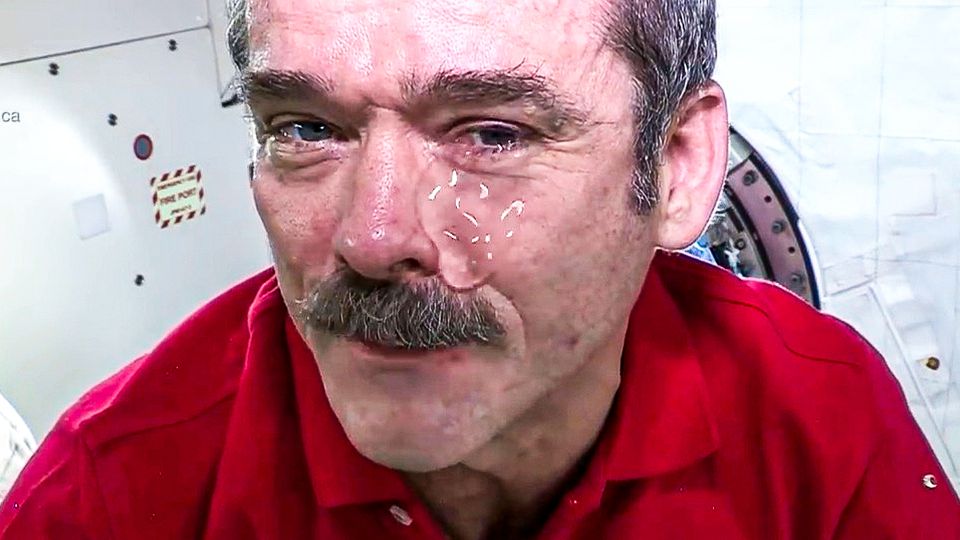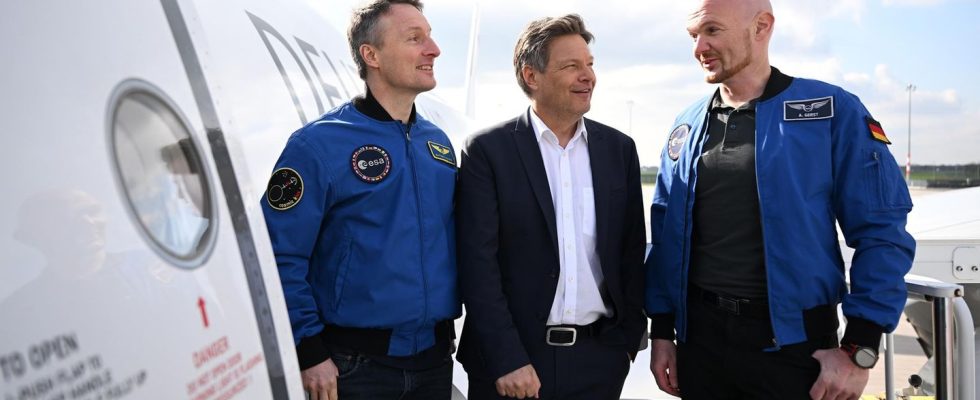On site
USA trip
How Robert Habeck in Washington helps put a German on the moon
Who goes to the moon? The Green Vice Chancellor Robert Habeck (m.) with the astronauts Matthias Maurer (l.) and Alexander Gerst
© Britta Pedersen/dpa
Vice Chancellor Robert Habeck is promoting close German-American cooperation in the USA – including on the “Artemis” lunar landing mission. He took the two German astronauts Alexander Gerst and Matthias Maurer with him.
When Robert Habeck flies to Washington, it is of course about the giant US investment program IRA, about the threat of protectionism, liquid gas and the return of the orange danger called Trump. But there is a second focus on what is now the German Vice Chancellor’s third trip to the USA: Robert Habeck wants to help ensure that the first German astronaut will soon arrive on the island Moon flies.
The Americans have started the “Artemis” lunar landing program to fly to our nearest neighbor in several missions over the next few years. Germany is the strongest supporter of the program, financially and technically. It is German technology that “provides the vital conditions for the astronauts,” says Habeck, “and I will promote the fact that German astronauts can fly to the moon with us as European partners.”
Habeck has two astronautics on board
That’s why Habeck not only took Anna Christmann, the Federal Government’s coordinator for aerospace, with him to Washington, but also the two men in blue ESA flight jackets, whom the Minister of Economic Affairs greeted with almost childlike enthusiasm on the tarmac in Berlin: the two German astronauts Alexander Gerst and Matthias Maurer.
“The moon is actually our eighth continent,” says Alexander Gerst. “Just as Antarctica was 100 years ago, which had to be rediscovered for science, now it is the moon.” He enthuses about research stations that will be there “in just a few decades.” And he warns that the moon is also an “economic area” – “and it is important that we as Europeans are involved and do not fall behind in future missions in Earth orbit and towards the moon.”
That is exactly what this most earthly mission is all about. Together with Habeck and Christmann, the astronauts will meet this Thursday Chirac Kerik, head of the National Space Council, which coordinates all American space activities and reports directly to Vice President Kamala Harris. The Europeans were promised to take part in three lunar missions – Germany, as the largest partner, should definitely be there. Time to at least try to get things done.
The success and failure of the mission depend on the German module
After all, the Europeans have more than just “something” to offer the Americans; the European Space Agency ESA supplies an important service module, developed and manufactured in Bremen. It is the first time in NASA’s history that such an important part of the project has been entrusted to a foreign partner; a part that belongs to the so-called “critical path”, on which the success or failure of the entire mission depends. Habeck is not the only one who sees this as a sign of great appreciation and trust in the capabilities of German engineering.
There is also the new education and training center in Cologne, which will open in September and will also be open to US astronauts. A complete seven-day lunar mission should be possible there – under real conditions. And further collaborations have long been planned, in the space observatory, in the measurement of gravitational waves or a mission to Venus. “Of course we also want to think long-term,” says Matthias Maurer.

The Space Age has just begun
If you listen to the astronauts, the Space Age has just begun. “Space travel is developing just like the Internet did 20 years ago,” enthuses Maurer. A real founding age had dawned, including a gold rush atmosphere. And if you don’t want to become dependent on space entrepreneurs like Elon Musk or Jeff Bezoz in the long term, you’d better go – or better: fly – yourself.
This is where Anna Christmann comes into play, the federal government’s coordinator for aerospace in Habeck’s ministry. Among other things, it is intended to ensure that the cooperation between ESA and NASA also leads to the greatest possible economic success in Germany. To the founding of startups that develop high-tech for space, build satellites or small rockets to take them into space, so-called micro launchers. Everything is already in progress. In Germany. It is a billion dollar market that is developing extremely dynamically. The global space economy’s total revenue grew by 70 percent from 2010 to 2021, to a staggering $469 billion.
“Why go to the moon of all places?”
But why go to the moon of all places? We (or at least the Americans) were there 50 years ago. Alexander Gerst again draws the Antarctic comparison: After the race to see who would reach the pole first, there was peace again in the eternal ice for a long time. The conqueror’s flag fluttered in the wind, why invest a lot of money and effort again?
That’s what people thought until scientists began to study Antarctica more intensively, pushed ahead with research and, decades later, triggered a real Antarctic boom. Just as the ice on Earth contains important historical climate data, the lunar surface holds secrets about Earth’s history – the Moon, essentially, a vast archive.
And perhaps the Europeans will eventually be able to complete the 400,000 kilometer journey without US help. “We Europeans can do it too, we have the technology,” says Matthias Maurer. “We just have to want to make it happen.”


